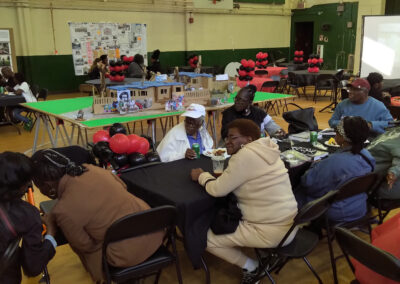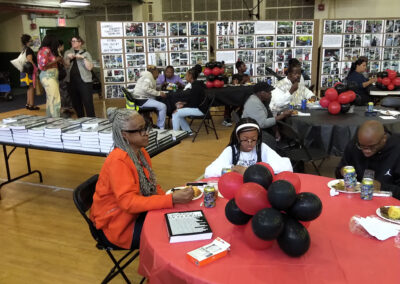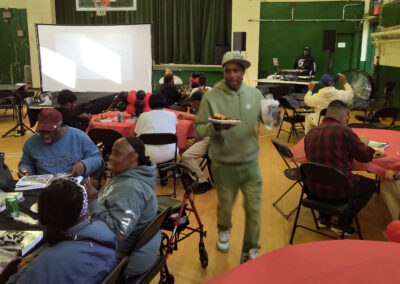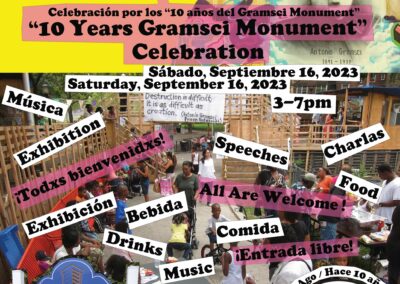10 Years “Gramsci Monument”
Forest Houses, Bronx, New York, 2023
Celebration
The “10-years Gramsci Monument”-Celebration is an important event. It is important because the idea, the initiative, and the desire to celebrate the memory of the “Gramsci Monument” 10 years after its venue in 2013, comes from Forest Houses. Precisely from Erik Farmer, President of the Forest Houses Tenants Association, who 10 years ago, was already the ‘key-figure’ of this work of art, during its creation and its daily production. This Celebration is also important for me, as the artist who created the work, for Yasmil Raymond, the project-curator and for Dia Art Foundation, the producer of the work. This celebration testifies and proves after 10 years, the power that this artwork has – precarious as it was in its form – through the density of its memory and the ramifications of its outcome. The “Gramsci Monument” is therefore a sustainable, eternal artwork. Okwui Enwezor once told me: “There is a time for work and there is a time for the celebration of the work.”
Participation
‘Participation’ is a very desired term in contemporary art. ‘Participation’ is often judge between ‘failure’ and ‘success’. At the “Gramsci Monument”, to participate meant being present and producing. Participation can only be the result of a presence and of a production, Participation cannot be reduced to a body movement. In order to provoke Participation, the artist himself/herself must be present and produce and understand this presence and this production as a gift, an offensive gift. At the “Gramsci Monument” the everyday presence and production of some of the residents constituted the work’s most valuable outcome. Their participation during those 77 days of summer 2013 constituted the core of the “Gramsci Monument”, gave it its soul and formed its spine. Such a precious ‘hard core’-Team is self-built in an organic way through mutual interest and reciprocal attraction. To have experienced this was a moment of grace.
Love
The only reason – today – for doing a Monument is Love and must be Love, the Love of those who wanted to build the Monument. The “Gramsci Monument” is an example, since I, the artist, love the work and life of Antonio Gramsci. There is no other reason beside the spirit and power of that Love. As author of the “Gramsci Monument” this love – my love – is the only motivation and also the only necessity to build a Monument to honor his life and work. Today – we see Monuments that have been disfigured, destroyed, dismantled. This happens when Monuments – and there are many – represent oppression, an oppressive historical time or even an oppressor. This is not just ‘vandalism’ of a few people bringing down Monuments, but the will of many showing us that these fallen Monuments were built on intimidation, fear, domination, and not on Love. Therefore, a Monument built without Love must fall one day or another, because – despite its heaviness, its dimensions, its materiality – it is not sustainable, and because only Love is sustainable.
Location
The location, NYCHA-Public Housing, Forest Houses, South Bronx, NYC, where the “Gramsci Monument” was built in 2013 is crucial and essential. But its real essence doesn’t come from a particular geographical location, diversity or economical representativity. The very essence of its location comes from its residents. The reason why the “Gramsci Monument” was built at Forest Houses was because I was invited to do so. Indeed, it was Erik Farmer, President of the Tenant Association of Forest Houses, whom I encountered with the help of Diane Herbert and Clyde Thompson (from the Community Center) – who said to me: “I will/we will help you do the “Gramsci Monument”, we will construct it and run it together.” Finding the location for an artwork such as the “Gramsci Monument” is one of the artist’s most important missions, because nobody can impose the location of a monument or of any artwork in public space. Finding the location is a noble mission, only achieved with a lot of Fieldwork and consequently, with the help of residents.
Monument
The idea of a Monument – as such – is a just, universal, and fair idea. All over the world there are Monuments, sometimes since centuries, but their aim should be interrogated critically. The questions we should ask an established Monument, but also a future Monument, are: What is the Monument’s Form? Which ecological, social, economic, scientific, political, military, or cultural achievements deserve a Monument today? If some of these accomplishments deserve a Monument, how then will this Monument honor them, and in which way will it celebrate their hero, author/authors? For how long will the Monument need to celebrate? Where should this celebration take place? These are the decisive points that require convincing responses for thinking a Monument today, because we need sustainable Monuments responding in their Form to the questions of Dedication, Location, Duration, Outcome.
Duration
The duration of a work of art is important. Every convincing artwork possesses sustainability despite its age or epoch of its creation, and despite the shape it has today. Artworks exist all around the world, which proves their very unique capacity to reach eternity beyond religious, economic, social, political, cultural habits. It is essential to understand the notions of ‘Duration’ or ‘Sustainability’ as terms for an emancipation of artistic positions and for the liberation of artistic forms. The form of something sustainable is always a breakthrough. What owns sustainability is what owns Intensity, Truth, Energy, Justice, Activity – Activity of Thinking – all the beautiful notions that art can touch and reach. Sustainable is what touches the soul. In its precariousness the “Gramsci Monument” tends to assert itself – far from materiality and being an object – as an artwork that created graceful and mysterious moments lasting forever. The Monument created itself its own sustainable memory. Worst would be to define sustainability and the question of duration in a reactionary way, that is, as material-linked or with object-related ‘qualities’.




